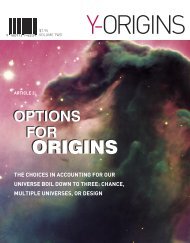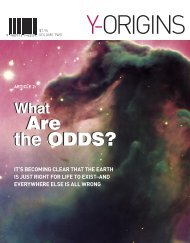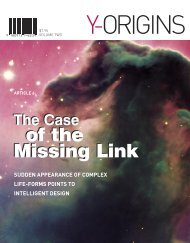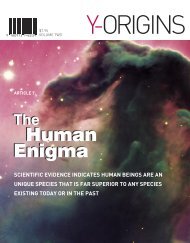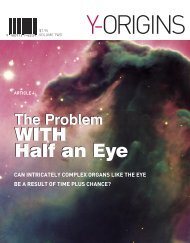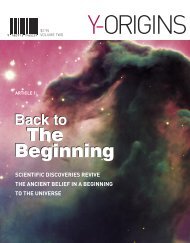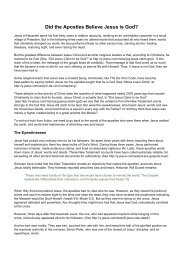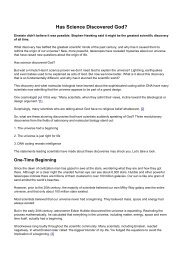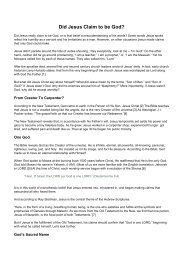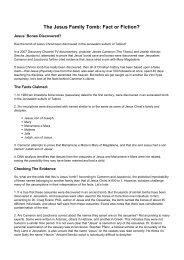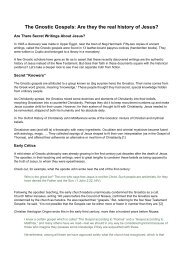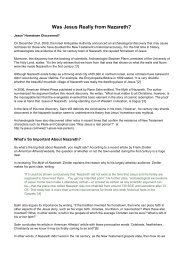1877
Create successful ePaper yourself
Turn your PDF publications into a flip-book with our unique Google optimized e-Paper software.
The Gospel of Barnabas: Secret Bible?<br />
Does a “secret Bible” discovered in a Turkish smuggling sting contain the real truth about the identity of Jesus<br />
Christ? According to a Turkish official, a 1,500-year-old ancient leather-bound text, secretly hidden for 12 years,<br />
could be an authentic version of the Gospel of Barnabas.<br />
Muslim blogs are going ballistic with the news of this discovery. According to some Islamic scholars, the Gospel of<br />
Barnabas was “suppressed by the Christian Church for its strong parallels with the Islamic view of<br />
Jesus.”[1] Reflecting this Muslim belief, an Islamic website survey reveals that over half of its readers believe the<br />
Gospel of Barnabas is the true Gospel of Jesus.[2] Muslim author Muhammad Ata ur-Rahim, claims, “The Gospel<br />
of Barnabas is the only known surviving Gospel written by a disciple of Jesus …“[3] Rahim claims the Gospel was<br />
widely circulated in the early church until A.D. 325.<br />
According to this “secret Bible,” Barnabas was one of Jesus’ original twelve apostles. However, in the book of<br />
Acts, Luke introduces Barnabas as an apostle who came after the original twelve, and was a fellow missionary<br />
with the apostle Paul. In their travels, Paul and Barnabas boldly declared Jesus’ death, resurrection and lordship<br />
in the first century.[4]<br />
A Different Jesus?<br />
Although the document entitled the Gospel of Barnabas contains much of the same information as the four New<br />
Testament Gospels, it differs greatly with regard to the identity of Jesus Christ. A few of the significant differences<br />
are that the Gospel of Barnabas:<br />
Denies Jesus’ deity<br />
Rejects the Trinity<br />
Denies Jesus’ crucifixion<br />
Denies Jesus as Messiah (this view disagrees with the Qur’an)<br />
The ancient Turkish manuscript departs from the teaching of the Qur’an by calling Muhammad the Messiah<br />
rather than Jesus.[5] However, like the Qur’an, the Gospel of Barnabas presents Jesus as a mere mortal. In it,<br />
Jesus supposedly says,<br />
“I confess before heaven, and call to witness everything that dwells upon the earth, that I am a stranger to<br />
all that men have said of me, to wit, that I am more than man. For I am a man, born of a woman, subject to<br />
the judgment of God; that live here like as other men, subject to the common miseries.”[6]<br />
Clearly the Gospel of Barnabas depicts Jesus denying his deity, whereas the apostle John clearly writes of Jesus<br />
as God the Son, Creator of the world:<br />
In the beginning was the Word, and the Word was with God, and the Word was God. He was with God in<br />
the beginning. Through him all things were made; without him nothing was made that has been<br />
made….The Word became flesh and made his dwelling among us. We have seen his glory…[7]<br />
Who Is The Real Jesus?<br />
In this passage, John claims he actually saw Jesus. Later he tells us he touched him, traveled with him and heard<br />
him teach for three years. He speaks about Jesus as a friend. But the writer of the Gospel of Barnabas makes no<br />
such claim.<br />
Both writings also differ regarding Jesus’ crucifixion. The Gospel of Barnabas presents Judas Iscariot as the one<br />
who died on the cross instead of Jesus, whereas in the New Testament, Judas betrays Jesus. In contradiction to
the Islamic teaching that Jesus’ death on the cross never occurred and was unnecessary, the entire Christian<br />
message is built upon the death of Jesus as the Savior for our sins and his resurrection as our hope of eternal<br />
life.[8]<br />
Both messages can’t be true. So how can we know which Jesus is real?<br />
Although scholars use several tests to determine a manuscript’s reliability, the most important is whether or not it<br />
is an eyewitness account. In a criminal trial, eyewitness testimony is always considered far superior to the<br />
testimony of someone who didn’t witness the crime.<br />
So can we know whether the Gospel of John or the Gospel of Barnabas is an eyewitness account?<br />
One reason scholars cite for John’s authorship is the fact early church historians attribute the writing to him. But<br />
in order to have been written by him, it must have been written during John’s lifetime. If evidence points to it<br />
being written after the early second century when John was dead, it couldn’t have been written by him.<br />
Likewise, if the Gospel of Barnabas was written after Barnabas’ lifetime, it too couldn’t have been an eyewitness<br />
account. However, if either gospel can be traced back to the first century, the likelihood of its reliability greatly<br />
increases. So what does the evidence tell us? Let’s begin with the Gospel of Barnabas.<br />
Is The Gospel Of Barnabas An Eyewitness Account?<br />
The “secret Bible” discovered in Turkey is said to be a fifteen-hundred-year-old copy. If true, it would have been<br />
written 400-500 years after Jesus’ death and resurrection, when eyewitnesses were dead. But since it’s a copy,<br />
the original could possibly have been written as early as the first century. To find out, we need to check the<br />
historical record from both Christian and Muslim history.<br />
There are only two ancient manuscripts of the Gospel of Barnabas other than the one discovered in Turkey: an<br />
Italian manuscript which dates to the fifteenth or sixteenth century, and a Spanish copy from around the same<br />
period which has been lost.[9] The text in the newly discovered Turkish manuscript is in Aramaic. None of these<br />
copies are in Greek, the language of Barnabas and the apostles.<br />
Two early Christian lists of apocryphal works, one from the fifth century and one from the seventh century,<br />
mention “A Gospel of Barnabas.” If these refer to the same Gospel, it would place its writing 400-500 years after<br />
Christ or earlier. But that still is several hundred years after the first century.<br />
The Acts of Barnabas is a fifth-century apocryphal work directed to the church of Cyprus that is sometimes<br />
mistakenly confused with the Gospel of Barnabas.<br />
The only book from the first century attributed to the apostle Barnabas is the Epistle of Barnabas, which is an<br />
apocryphal writing not in the New Testament. This first-century letter speaks of Jesus as the crucified and<br />
resurrected Lord. Scholars believe it was written by Barnabas between A.D. 70 and 90.<br />
But if Barnabas writes of Jesus as Lord in the first century Epistle of Barnabas, why would he then write of Jesus<br />
as merely a prophet in the Gospel of Barnabas? Why would he write two contradictory accounts of Jesus?<br />
The Epistle of Barnabas is accepted by scholars as an authentic first-century account of Jesus that agrees with<br />
the New Testament. However, the Gospel of Barnabas is a completely different book with a completely different<br />
timeline.<br />
The following evidence suggests that the Gospel of Barnabas wasn’t recognized as a first-century gospel by early<br />
Muslims or Christians:[10]<br />
No Muslim writer refers to it until the fifteenth or sixteenth century.<br />
No Christian writer refers to it from the first to the fifteenth century.
The earliest reference to it was made in the fifth century, but it is in doubt.<br />
It cites historical facts that didn’t exist until hundreds of years later.[11]<br />
A Medieval Forgery?<br />
A major question we need to ask is: Why wouldn’t Muslim scholars have written about the Gospel of Barnabas if<br />
it had been in existence when Muslims and Christians were in heated debate about the identity of Christ between<br />
the seventh and fifteenth centuries? Not one mention of the work exists.<br />
Furthermore, Christian writers such as Irenaeus wrote extensively about anti-Christian documents such as the<br />
Gnostic gospels, classifying them as heretical. Yet, in spite of assertions by the Islamic writer Rahim, not one of<br />
Ireneaus’ letters or documents mentions the Gospel of Barnabas. There is simply no mention of it from any early<br />
Christian or Muslim writer.<br />
Perhaps most indicative of its late date is that the Gospel of Barnabas describes medieval life in Western Europe,<br />
as well as a 100-year Jubilee, which wasn’t declared until the fourteenth century. How would Barnabas or any<br />
first-century writer know such historical detail hundreds of years before it was declared?<br />
Dr. Norman Geisler concludes, “The evidence that this was not a first-century gospel, written by a disciple of<br />
Christ, is overwhelming.”[12]<br />
Not only does the evidence argue against it being written by Barnabas in the first century, but some scholars<br />
believe the Gospel is a forgery. One expert writes, “In my opinion scholarly research has proved absolutely that<br />
this ‘gospel’ is a fake.”[13]<br />
Christian and secular scholars are not alone in their verdict that someone tampered with the text, fraudulently<br />
making it appear to be the work of Paul’s companion, Barnabas. This opinion is also held by a number of Muslim<br />
scholars.[14] The Concise Encyclopedia of Islam states, “As regards the ‘Gospel of Barnabas’ itself, there is no<br />
question that it is a medieval forgery.”[15]<br />
But as noted previously, Muslim scholars likewise argue that the New Testament message was “corrupted” by<br />
the Church, presenting a different Jesus than the one who walked the hills of Galilee 2,000 years ago. That leads<br />
us to the question of its reliability. Can we discover the real Jesus through its pages?<br />
Is The New Testament Reliable?<br />
So were the New Testament books written early enough to have been eyewitness accounts? If so, they must<br />
have been written during the first century. Let’s examine the evidence, and compare the dating of the New<br />
Testament with what we have discovered for the Gospel of Barnabas.<br />
History provides clues from three primary sources regarding the date of origin for the 27 books of the New<br />
Testament:<br />
Testimony of Church Enemies<br />
Early Christian Accounts<br />
Early Manuscript Copies<br />
Testimony Of Heretics<br />
The first clue is a partial list of New Testament books made by enemies of the Church called heretics. As outlaws<br />
of the Church, heretics wouldn’t have been concerned about agreeing with Church leaders about the authorship<br />
or dating of the New Testament. Yet, two early heretics, Marcion and Valentinus, did attribute the writings of<br />
several New Testament books and passages to the apostles.<br />
In A.D. 140, the heretic Marcion listed 11 of the 27 New Testament books as being the authentic writings of the<br />
apostles.
About the same time, another heretic, Valentinus, alludes to a wide variety of New Testament themes and<br />
passages.<br />
This tells us that by the middle of the second century many New Testament books had been in circulation for<br />
some time. Even heretic “outlaws” accepted these New Testament accounts as eyewitness reports from the<br />
apostles.<br />
Early Christian Accounts<br />
Our second clue is the vast number of early Christian letters, sermons, commentaries, and creeds referring to<br />
Jesus as the resurrected Lord. They appeared as early as five years after his crucifixion. Although many writings<br />
were burned under the edict of the Roman emperor Diocletian, thousands survived.<br />
The number of these documents is impressive; more than 36,000 complete or partial writings, some from the first<br />
century, have been discovered.[16] Their words could replicate virtually the entire New Testament except for a<br />
few verses.[17]<br />
So how does that compare with the Gospel of Barnabas? We have already noted that there are only two citations<br />
of it prior to the fifteenth century, and it is doubtful those references were to the “Gospel of Barnabas” in<br />
question.[18]<br />
The earliest writings outside the New Testament were from men who knew and followed Paul, Peter, John and<br />
the other apostles. These early church leaders were not eyewitnesses to Jesus, but learned about him from those<br />
who had actually seen and heard him. Significantly, their writings confirm many New Testament details about<br />
Jesus, including his crucifixion and resurrection.<br />
The most important of these early writings outside the New Testament are from Clement of Rome, Ignatius of<br />
Antioch, and Polycarp of Smyrna.<br />
In A.D. 96, Clement of Rome wrote a lengthy letter to the church at Corinth in which he cited Matthew, John, and<br />
1 Corinthians. Some believe he is the Clement mentioned by Paul in Philippians 4:3. Since Clement’s letter was<br />
written in A.D. 96, these three books must have been written earlier.<br />
In about A.D. 110, Ignatius of Antioch, a disciple of the apostle John, wrote six letters to churches and one to a<br />
fellow bishop, Polycarp, in which he refers to six of Paul’s letters.<br />
Polycarp of Smyrna, also a disciple of the apostle John, makes reference to all 27 New Testament books in his<br />
letter to the Philippian church (A.D. 110-135). Therefore, the gospels must have been in existence during the first<br />
century while some eyewitnesses (including John) were still alive.<br />
We have seen that no such early reference to the Gospel of Barnabas exists.<br />
Early Manuscript Copies<br />
Our third clue is the abundance of early New Testament manuscripts which have helped scholars determine the<br />
approximate time they were originally composed. Archaeologists have discovered over 5,600 manuscript copies<br />
of the New Testament in the original Greek language, some complete books, and some mere fragments.<br />
Counting other languages, there are over 24,000.[19]<br />
Quite clearly, 5,600 to three is an enormous numerical manuscript advantage for the New Testament.<br />
Furthermore, archaeologists have discovered New Testament fragments that date to within a generation or two<br />
after Christ, compared with hundreds of years later for the Gospel of Barnabas.<br />
In the early twentieth century, a fragment of the Gospel of John was discovered in Egypt (specifically, P52: John<br />
18:31-33) dated A.D. 117-138. Renowned biblical scholar Bruce Metzger noted the significance of this remarkable
discovery:<br />
Just as Robinson Crusoe, seeing but a single footprint in the sand, concluded that another human being,<br />
with two feet, was present on the island with him, so P52 [the label of the fragment] proves the existence<br />
and use of the Fourth Gospel during the first half of the second century … “[20]<br />
The discovery of this fragment means that within one generation of John writing his Gospel, a copy of it had<br />
migrated all the way from Asia Minor to Egypt.<br />
There are many other early manuscripts dated from the late second century to the fourth and fifth centuries. Entire<br />
books of the New Testament dated from A.D. 200-1500 are preserved in various museums (Bodmer Papyri).[21]<br />
An even earlier papyrus fragment from the Dead Seas Scrolls (7Q5) has been identified by a paleographer as a<br />
piece of the Gospel of Mark dated around A.D. 50, significantly earlier than the P52 fragment of John.<br />
New Testament professor, Daniel B. Wallace, who has studied the Dead Sea Scroll fragment, agrees it is from the<br />
first century.[22] Although there is debate over this fragment, the collective evidence from other manuscripts<br />
strongly supports a New Testament written in the first century.<br />
Scholars’ Consensus<br />
Prior to these findings, German critical scholars from the late nineteenth and early twentieth centuries had argued<br />
that the New Testament was written by unknown authors in the second century. But this new evidence reveals<br />
that its books were all written in the first century. Historian Paul Johnson writes:<br />
The late nineteenth-early twentieth-century notion that the New Testament was a collection of late and highly<br />
imaginative records can no longer be seriously held. No one now doubts that St. Paul’s epistles, the earliest<br />
Christian records, are authentic or dates them later than the A.D. 50s.[23]<br />
Archaeologist William Albright concluded that the entire New Testament was written at “very probably sometime<br />
between about 50 A.D. and 75 A.D.”[24]<br />
Cambridge scholar John A. T. Robinson argues for even earlier dates. He believes that most of the New<br />
Testament was written between A.D. 40 and 65.[25] Robinson bases his conclusion primarily on the fact that all<br />
the New Testament books are silent about the destruction of Jerusalem. Such a key event would certainly have<br />
been mentioned by them had it occurred prior to their writings.<br />
Further evidence for early dating is that the deaths of Peter and Paul in A.D. 66 aren’t mentioned in any book.<br />
There is an incredible amount of detail written about their lives in the New Testament; why not their deaths? That<br />
convinces many scholars that their deaths hadn’t yet occurred at the time of the writings.<br />
The consensus of most scholars today is that the letters of Paul begin in the early 50s, and the Synoptic Gospels<br />
(Matthew, Mark & Luke) were written in the early to mid-60s.[26]Estimates on other books range from A.D. 40-95,<br />
but the consensus is that all New Testament writings were composed in the first century.<br />
These conclusions mean that the New Testament accounts about Jesus were written anywhere from seven to 30<br />
years after his death, when thousands of eyewitnesses would have been alive to falsify the reports if they were<br />
wrong. Yet no such challenge to these eyewitness accounts exists.<br />
Evidence for the reliability of the New Testament exceeds that of all other ancient history. John A. T. Robinson<br />
writes, “The wealth of manuscripts, and above all the narrow interval of time between the writing and the earliest<br />
extant copies, make it by far the best attested text of any ancient writing in the world.”[27]<br />
In fact, the New Testament has far more manuscripts dated far earlier than the Gospel of Barnabas as the chart
elow reveals.<br />
Compare The New Testament And The Gospel Of Barnabas<br />
RELIABILITY TESTS<br />
NEW TESTAMENT<br />
GOSPEL OF BARNABAS<br />
Date of Original A.D. 40-95 A.D. 400-1500<br />
Earliest Verified Copies A.D. 117-138 A.D. 400-1500<br />
Gap from Original 22-98 years Undetermined<br />
Years after Christ 7-30 370-1,470<br />
Number of Manuscripts in Original Language 5,600+ None<br />
Number of Manuscripts in All Languages 24,000+ 3<br />
Citations in other Historical Documents 36,000+ 2<br />
Conclusion<br />
Whereas the “secret Bible” called the Gospel of Barnabas was written 400-1500 years after Christ, most scholars<br />
believe the Gospels of Matthew, Mark, Luke and John were written in the first century, within one generation of his<br />
life.<br />
As one reads the New Testament, it becomes apparent that the writers made every attempt to honestly record the<br />
life, words and events surrounding Jesus. Luke, the writer of both the Gospel of Luke and the book of Acts, puts it<br />
this way,<br />
Many people have set out to write accounts about the events that have been fulfilled among us. They used<br />
the eyewitness reports circulating among us from the early disciples. Having carefully investigated<br />
everything from the beginning, I also have decided to write a careful account for you, most honorable<br />
Theophilus, so you can be certain of the truth of everything you were taught.[28]<br />
The early writing of the New Testament strongly suggests that we can know what Jesus taught and what he was<br />
really like from the words of those who knew him, the eyewitnesses. One eyewitness, the apostle Peter, wrote:<br />
For we were not making up clever stories when we told you about the powerful coming of our Lord Jesus<br />
Christ. We saw his majestic splendor with our own eyes.[29]<br />
Peter and the other eyewitnesses boldly proclaimed “Jesus as Lord” at the risk of losing their lives. Perhaps the<br />
legacy of their unswerving commitment is the most compelling evidence of all that the New Testament, not the<br />
Gospel of Barnabas, presents the real Jesus.<br />
Endnotes<br />
1. Daily Mail Reporter, The Daily Mail Online, February 29, 2012, http://www.dailymail.co.uk/news/article-210<br />
5714/Secret-14million-Bible-Jesus-predicts-coming-Prophet-Muhammad-unearthed-Turkey.html.<br />
2. http://www.barnabas.net/component/poll/15-i-think-the-gospel-of-barnabas-is-true-gospel-of-jesus.html.<br />
3. Muhammad Ata ur-Rahim, Jesus: Prophet of Islam, (1996), 41.<br />
4. Acts 13:1-3, 33.<br />
5. Compare: Gospel of Barnabas, sects. 42, 48; Qur’an, cf. suras 5:19, 75.<br />
6. Gospel of Barnabas, 94:1.<br />
7. John 1:1-3, 14. NIV [See http://www.biblegateway.com/passage/?search=John%201:1-14&version=NIV].<br />
8. 1 John 5:11-13. 1 John 5:11-13.<br />
9. Geisler & Saleeb, Ibid.
Powered by TCPDF (www.tcpdf.org)<br />
10. Norman Geisler & Abdul Saleeb, Answering Islam (Grand Rapids, MI: Baker, 2002), 303-307.<br />
11. John Gilchrist, “Origins and Sources of the Gospel of Barnabas,”<br />
http://www.bible.ca/islam/library/Gilchrist/barnabas.htm.<br />
12. Geisler & Saleeb, Ibid.<br />
13. J. Slomp, “The Gospel Dispute,” Islamochristiana, 68. Also see:<br />
http://rationalislam.blogspot.com/2012/02/secret-bible-which-predicts-coming-of.html<br />
14. Ibid.<br />
15. Cyril Glassé, The Concise Encyclopedia of Islam, San Francisco: Harper & Row, 1989, p. 65.<br />
16. Norman L. Geisler and Paul K. Hoffman, eds., Why I Am a Christian (Grand Rapids, MI: Baker, 2001),<br />
150.<br />
17. Bruce M. Metzger, The Text Of The New Testament (New York: Oxford University Press, 1992), 86.<br />
18. This early reference might have been to one of the other books named after the apostle Barnabas: the<br />
Epistle of Barnabas or the Acts of Barnabas. Scholars question that it refers to the Gospel of Barnabas<br />
because there is no other historical document supporting it.<br />
19. Josh McDowell, The New Evidence That Demands a Verdict (Nashville: Thomas Nelson, 1999), 33–68.<br />
20. Metzger, 39.<br />
21. Ibid.<br />
22. Cited in Christian Post, Stoyan Zaimov, “Gospel of Mark Fragments Reportedly Found; Possibly Oldest<br />
NT Artifacts” February 17, 2012, http://www.christianpost.com/news/gospel-of-mark-fragments-reportedlyfound-possibly-oldest-nt-artifacts-69778/.<br />
23. Paul Johnson, “A Historian Looks At Jesus,” Speech to Dallas Theological Seminary, 1986.<br />
24. William F. Albright, “Toward A More Conservative View,” Christianity Today, January 18, 1993.<br />
25. John A. T. Robinson, quoted in Norman L. Geisler & Frank Turek, I Don’t Have enough Faith To Be An<br />
Atheist (Wheaton, IL: Crossway, 2004), 243.<br />
26. For a detailed analysis see http://www.errantskeptics.org/DatingNT.htm.<br />
27. John A. T. Robinson, Can We Trust The New Testament? (Grand Rapids: Eerdmans, 1977), 36.<br />
28. Luke 1:1-4, NLT.<br />
29. 2 Peter 1:16, NLT.<br />
Permission to reproduce this article: Publisher grants permission to reproduce this material without written<br />
approval, but only in its entirety and only for non-profit use. No part of this material may be altered or used out of<br />
context without publisher’s written permission. Printed copies of this article and Y-Origins and Y-Jesus magazine<br />
may be ordered at: http://jesusonlineministries.com/resources/products/<br />
© 2011 JesusOnline Ministries. This article is a supplement to Y-Jesus magazine by Bright Media Foundation &<br />
B&L Publications: Larry Chapman, Chief Editor.



